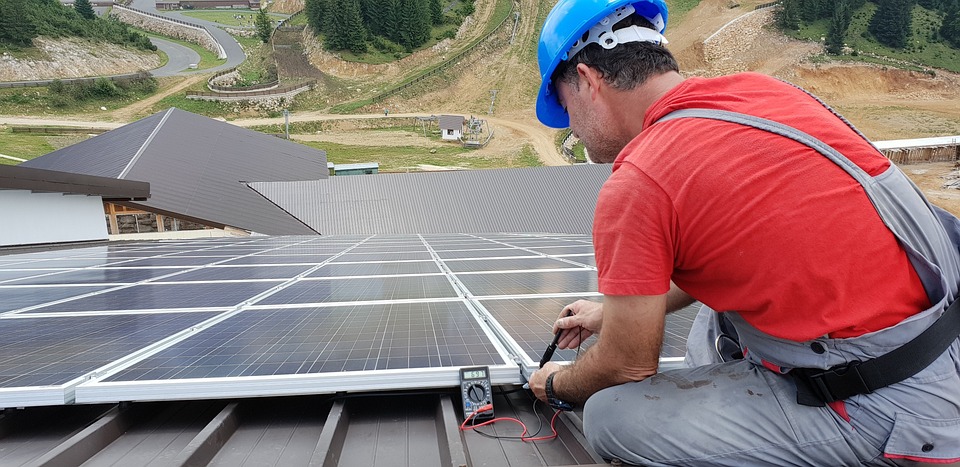The Rise of Solar Energy: How Installation is Making an Impact
Solar energy has experienced a meteoric rise in recent years, driven by advancements in technology, decreasing costs, and growing environmental concerns. The installation of solar panels has played a vital role in this transformation, contributing to an increasingly sustainable energy landscape. In this article, we will explore the impact of solar energy installation and its role in the rise of solar energy.
The Growing Demand for Solar Energy
The demand for solar energy has been steadily increasing as individuals, businesses, and governments seek to reduce their carbon footprint and transition to renewable energy sources. According to the International Energy Agency (IEA), the installed capacity of solar photovoltaic (PV) systems is expected to reach 1.3 terawatts by 2023, accounting for nearly 30% of global electricity generation. This soaring demand for solar energy has been fueled by the installation of solar panels, which has become more affordable and accessible than ever before.
Cost-Effective Installation
One of the key drivers of the rise of solar energy is the cost-effectiveness of installing solar panels. Over the past decade, the cost of solar panels has plummeted, making them a viable and attractive option for homeowners and businesses. According to the Solar Energy Industries Association (SEIA), the cost of solar PV systems has dropped by more than 70% since 2010. This significant reduction in costs has made solar energy installation an economically feasible solution for many, driving the widespread adoption of solar power.
Government Incentives and Policies
Government incentives and policies have also played a crucial role in promoting the installation of solar energy systems. Many countries have implemented subsidies, tax credits, and feed-in tariffs to encourage the adoption of solar power. For example, the Investment Tax Credit (ITC) in the United States provides a 26% tax credit for residential and commercial solar energy systems installed before 2023. These incentives have significantly lowered the upfront costs of solar installation, making it an attractive investment for many consumers.
Environmental Impact of Solar Energy Installation
The installation of solar panels has had a profound environmental impact, contributing to the reduction of greenhouse gas emissions and the conservation of natural resources. By harnessing the power of the sun, solar energy helps to displace the use of fossil fuels for electricity generation, thereby mitigating the environmental impact associated with burning coal, oil, and natural gas.
Reduction of Greenhouse Gas Emissions
Solar energy is a clean and renewable energy source that produces electricity without emitting harmful pollutants or greenhouse gases. According to the National Renewable Energy Laboratory (NREL), the installation of solar panels accounted for a reduction of 34 million metric tons of carbon dioxide emissions in 2018 alone. This significant reduction in greenhouse gas emissions highlights the environmental benefits of solar energy installation and its role in combating climate change.
Conservation of Natural Resources
Furthermore, the installation of solar panels helps to conserve natural resources by reducing the reliance on finite fossil fuel reserves. In contrast to fossil fuel extraction, which can have detrimental effects on the environment, solar energy generation relies on an abundant and inexhaustible energy source: the sun. By harnessing solar power, we can minimize our impact on the environment and ensure the sustainability of our energy supply for future generations.
The Economic Impact of Solar Energy Installation
In addition to its environmental benefits, the installation of solar panels has also had a positive impact on the economy, creating jobs and driving economic growth in the renewable energy sector. According to the US Bureau of Labor Statistics, the number of solar installers is projected to grow by 51% from 2019 to 2029, far outpacing the average growth rate for all occupations. This surge in job opportunities reflects the increasing demand for solar energy installation and the growing market for renewable energy technologies.
Job Creation and Economic Growth
The installation of solar panels has created a wealth of job opportunities, ranging from manufacturing and installation to maintenance and research and development. In addition to job creation, the renewable energy sector has driven economic growth, attracting investments and stimulating innovation in solar technology. As the transition to solar energy continues, the economic impact of solar installation will be a key driver of sustainable development and prosperity.
Conclusion
The installation of solar panels has played a pivotal role in the rise of solar energy, contributing to the growing demand for clean, sustainable, and cost-effective electricity. With its significant environmental, economic, and social impact, solar energy installation has become a driving force in the transition to a more sustainable energy landscape. As technology continues to evolve and costs continue to decline, the installation of solar panels will continue to make a lasting impact, shaping the future of energy generation and consumption.


Pingback: The Rise of Solar Energy: How Installation is Making an Impact – Home Solar Sessions
Your point of view caught my eye and was very interesting. Thanks. I have a question for you.
перепродажа аккаунтов магазин аккаунтов
маркетплейс для реселлеров магазин аккаунтов
покупка аккаунтов маркетплейс аккаунтов
маркетплейс аккаунтов гарантия при продаже аккаунтов
магазин аккаунтов социальных сетей аккаунты с балансом
заработок на аккаунтах заработок на аккаунтах
биржа аккаунтов https://birzha-akkauntov-online.ru/
продажа аккаунтов продажа аккаунтов соцсетей
платформа для покупки аккаунтов площадка для продажи аккаунтов
продать аккаунт https://ploshadka-prodazha-akkauntov.ru
магазин аккаунтов биржа аккаунтов
маркетплейс аккаунтов продать аккаунт
купить аккаунт с прокачкой https://pokupka-akkauntov-online.ru
Sell accounts Account exchange
Account Acquisition Account marketplace
Account Purchase Database of Accounts for Sale
Profitable Account Sales Account Market
Sell accounts Profitable Account Sales
Sell Account Account Selling Platform
Account Buying Service Accounts for Sale
Account Buying Platform socialmediaaccountsshop.com
Account Selling Service Account trading platform
Account Sale Sell accounts
Account Acquisition Account Trading Platform
find accounts for sale accounts for sale
secure account purchasing platform account acquisition
account sale account exchange service
marketplace for ready-made accounts account market
account market database of accounts for sale
ready-made accounts for sale purchase ready-made accounts
account store buy account
ready-made accounts for sale https://accountsmarketdiscount.com
account acquisition account market
buy and sell accounts account trading service
ready-made accounts for sale website for selling accounts
account marketplace buy and sell accounts
account trading platform account selling service
account exchange secure account purchasing platform
marketplace for ready-made accounts accounts market
account market account market
verified accounts for sale website for selling accounts
ready-made accounts for sale account market
accounts marketplace accounts marketplace
account trading platform gaming account marketplace
account market find accounts for sale
accounts marketplace account trading service
account trading account store
account store buy accounts
account trading platform account buying service
buy accounts buy pre-made account
account market sell pre-made account
account sale buy pre-made account
website for selling accounts https://accounts-offer.org/
buy account buy accounts
account buying platform https://buy-best-accounts.org/
find accounts for sale https://social-accounts-marketplaces.live/
account market https://accounts-marketplace.live
online account store https://social-accounts-marketplace.xyz
buy accounts https://buy-accounts.space
sell pre-made account account marketplace
account trading platform accounts market
marketplace for ready-made accounts https://social-accounts-marketplace.live
Is it possible to lease solar panels instead of buying, and what factors should I consider when deciding which financing option to choose for my home solar system? My blog
profitable account sales https://buy-accounts.live
buy account https://accounts-marketplace.online
account market account marketplace
магазин аккаунтов купить аккаунт
маркетплейс аккаунтов rynok-akkauntov.top
биржа аккаунтов https://kupit-akkaunt.xyz/
магазин аккаунтов akkaunt-magazin.online
продажа аккаунтов https://akkaunty-market.live/
магазин аккаунтов https://kupit-akkaunty-market.xyz
покупка аккаунтов https://akkaunty-optom.live
продажа аккаунтов маркетплейсов аккаунтов
купить аккаунт https://akkaunty-dlya-prodazhi.pro/
покупка аккаунтов kupit-akkaunt.online
buy fb account facebook accounts to buy
buying facebook ad account buy aged fb account
buying facebook account https://buy-ad-account.top
cheap facebook accounts buy fb ad account
buy fb ads account https://ad-account-buy.top
buy facebook advertising buy facebook account for ads
buy accounts facebook https://ad-account-for-sale.top
facebook account buy https://buy-ad-account.click/
fb account for sale https://ad-accounts-for-sale.work
buy google ads sell google ads account
google ads account seller https://buy-ads-accounts.click/
buy facebook ads accounts facebook ad account buy
google ads accounts https://ads-account-for-sale.top
buy google ads threshold account https://ads-account-buy.work
buy google ad threshold account https://buy-ads-invoice-account.top
buy adwords account https://buy-account-ads.work
google ads agency accounts https://buy-ads-agency-account.top
buy aged google ads accounts https://sell-ads-account.click
buy google ad account ads-agency-account-buy.click
buy facebook verified business manager https://buy-business-manager.org
buy google ads https://buy-verified-ads-account.work
verified bm for sale buy facebook business managers
buy facebook verified business account buy verified facebook business manager account
buy facebook verified business account buy-verified-business-manager.org
verified bm facebook bm account buy
verified bm https://buy-business-manager-verified.org/
facebook bm account https://buy-bm.org
buy facebook business manager accounts https://verified-business-manager-for-sale.org/
facebook bm buy https://buy-business-manager-accounts.org
buy tiktok ad account https://buy-tiktok-ads-account.org
tiktok ads account buy https://tiktok-ads-account-buy.org
buy tiktok ads accounts https://tiktok-ads-account-for-sale.org
tiktok ad accounts https://tiktok-agency-account-for-sale.org
buy tiktok business account https://buy-tiktok-ad-account.org
buy tiktok ad account https://buy-tiktok-business-account.org
buy tiktok ads accounts https://buy-tiktok-ads.org
buy tiktok ads accounts https://tiktok-ads-agency-account.org
Explore the ranked best online casinos of 2025. Compare bonuses, game selections, and trustworthiness of top platforms for secure and rewarding gameplaycasino slot machine.
Your article helped me a lot, is there any more related content? Thanks!
Exploring the Unconventional: Could Solar Panel Installation Quotes Include a Carbon Footprint Analysis to Encourage More Sustainable Practices among Customers? when to give phone number online dating
как отключить мобильный интернет в роуминге
fb accounts for sale account acquisition guaranteed accounts
cheap facebook accounts account sale account market
Your article helped me a lot, is there any more related content? Thanks!
Thank you for your sharing. I am worried that I lack creative ideas. It is your article that makes me full of hope. Thank you. But, I have a question, can you help me?
Your article helped me a lot, is there any more related content? Thanks!
The way you framed [argument/idea] made me reconsider my own stance on… For anyone interested, Cron Expression Parser has great resources on this.
I’m grateful for the time and effort you’ve invested in creating this valuable resource.
Your attention to detail and commitment to accuracy is truly commendable. Well done!
The clarity of your explanations makes even the most difficult concepts easy to grasp.
I love how your posts always have such a fresh perspective on things.
I’m grateful for the clear, actionable advice you’ve provided in this article.
I found this article incredibly insightful. Thank you for sharing your expertise.
Your content always feels so well-researched and thoughtful—thank you for that.
Great article! Very informative and well-written.
Very helpful content, learned a lot from this.
Great article! Very informative and well-written.
This is exactly what I was looking for. Bookmarked!